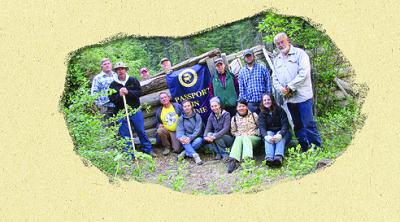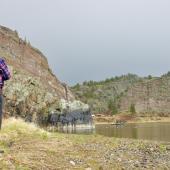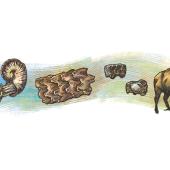Uncovering Montana's Chinese Past
Hard-packed earth gave way to the archaeologists’ trowels as they exposed the weathered floorboards of a former Chinese laundry in Big Timber. Carefully working through the splintered threshold to the sandy soil underneath it, a trowel hit something that was not wood. Brushing dirt from the fragile pieces, a mysterious find came to light. Beneath the wooden doorway, where it had been intentionally placed long ago, were the delicate remains of a domestic cat’s paw.
Tales of Chinese terraces drew archaeologist Christopher Merritt to a heavily timbered area in Sanders County in 2006. The site was unlike any other in Montana. The rock-lined terraces, moss-covered with age, spanned several hundred feet cut into a steep hillside. Forest Service archaeologists discovered the terraces in 1979, tucked away in an obscure drainage known as Poacher Gulch. Locals believed that Chinese miners built them. As the story went, Chinese workers laying tracks of the Northern Pacific Railroad along the Clark Fork River in 1883, underpaid and mistreated, left their jobs to search the hills for gold and silver. It was logical, and these terraces resembled terraces Chinese farmers constructed in Idaho’s Payette National Forest. Between 1979 and 2006, the Chinese terrace theory was so convincing that it nearly became fact.

Chris was beginning his doctoral work at the University of Montana and searching for a dissertation topic. The Chinese, and the lack of information about them, fascinated him. These important pioneers, almost exclusively male, contributed significantly to the settling of Montana, yet their story had almost entirely escaped the pages of the state’s written history. By 1870, Chinese comprised ten percent of Montana’s population, but by the mid-1950s, few remained. Their homes and businesses fell victim to urban renewal programs. Time erased their remote mining and railroad camps. Traces of their culture disappeared, and their stories became the stuff of myth and legend. Archaeology could help unravel their mysterious legacy.
Partnering with the Forest Service and archaeologist Milo McLeod, Chris and UM professor Dr. Kelly Dixon planned field investigations for summer 2007. They assumed they would discover evidence of 1880s Chinese occupation, when laborers were laying track along the Clark Fork. However, they found no evidence of Chinese. Instead, they found the cultivation of corn on the terraces, thousands of tiny pieces of tarpaper, mushy wood, and nails dating to the early 1900s.
Chris saw the failure of Poacher Gulch as a “gateway to understanding.” Chinese pioneers mined claims, helped build the railroad, owned businesses and paid taxes, yet endured discriminatory laws and social injustice. Neither accepted nor understood, the Chinese dwindled in numbers leaving hardly a trace. The idea that an absent population could fuel strong and persistent misperceptions shaped Chris’ work over the next several years as he broadened his search.
Chris was not the only archaeologist to study Montana’s Chinese. But his significant work tied previous attempts at analysis together. Archaeological collections, unprocessed and long stored away, offered invaluable additions to the record Chris began to compile. Excavations by others in recent years had yielded thousands of artifacts, but raised more questions. And, without a Montana collection to serve as a typology, there could be no accurate analysis. Two small collections, from China Gulch and Cinkers (historically known as Louiseville) at Cedar Creek in Mineral County, provided that basis.
Forest Service archaeologists excavated these sites in 1995. Historic records confirmed that Chinese lived in Cedar Creek during the late 1860s and 1870s. Chris was thrilled to discover this collection as it contained the first Chinese artifacts he had seen in Montana. Items typical of western Chinese settlements included celadon and bamboo style semi-porcelain bowls, fragments of brown-glazed stoneware, and opium cans. At China Gulch, there were curious u-shaped, hand-stacked rock hearths and mysterious small metal trays the archaeologists originally called ‘thingies.’ Chris called in an expert. University of Idaho’s Dr. Priscilla Wegars identified the “thingies” as “funs” trays, modified opium cans used to weigh and measure the drug. These wonderful collections, stored away for a decade, spurred Chris on. Over the next few years, he tirelessly traversed the footsteps of the vanished Chinese to remote camps and ghost towns in National Forests, urban neighborhoods, and cemeteries. Slowly Chris began to put some of the pieces in place.
Chris led new excavations at Cedar Creek. Chinese hearths yielded clues about the poor quality of life in this remote mining camp where there were 300 Chinese in the winter of 1870. Analysis of pig, deer, and sheep bone fragments found in the hearths revealed that they had been processed—or cooked—at least four different times. This tells a sad story: the people living there were starving, and making do with very little. The hearths found here and elsewhere in Montana are unique to the Chinese. They are not the same as the Italian or Slavic bread ovens, often mistakenly called “Chinese ovens.” Chinese did not make bread.
Another large collection of artifacts from German Gulch near Butte, excavated in the 1980s, also lay gathering dust. Chris organized volunteers to catalogue and sort this huge collection. Chris was astonished to discover that the site was a self-contained community. Opium dens, stores, and communal cooking areas offered the best variety of Chinese materials found in Montana to date. The collection included imported foodstuffs like Chinese dates and olives, sheephead fish, and flounder, illustrating a sophisticated trade network. Although the buildings are long gone, one feature at the site—in addition to hearths—is a type of kiln, possibly a crematorium. While there is no physical evidence of human cremation, the New Northwest magazine noted in 1874 the cremation of six Chinese at German Gulch. Sojourning Chinese often purchased insurance to guarantee the return of their remains—or perhaps ashes—to native soil should they die abroad.
The railroad town of Big Timber attracted Chinese who left their jobs with the Northern Pacific and settled there. In 2008, students following Chris’ lead uncovered a Chinese restaurant and laundry next to a brothel. Historic maps show Chinese businesses and a “female boarding house” operating in the neighborhood in the early 1900s. Red light districts and Chinese settlements, both housing outcast populations, were often adjacent. Volunteers unearthed 35,000 artifacts, which comprise Montana’s only known Chinese deposit of the 1930s and 1940s. Among the artifacts are a bluing ball used in laundry operations, pieces of a Chinese game known as “go,” and the cat’s paw—likely a talisman—that still defies explanation. The crew also accessed Big Timber’s tunnels, which locals insist are Chinese. But in Big Timber as in other communities, passageways dubbed “Chinese tunnels” are nothing more than convenient access or under sidewalk storage.
Chris studied Northern Pacific Railroad camps, where Chinese laborers worked for pitiful wages. He visited cemeteries in Helena, Butte, and Philipsburg where Chinese remains were not returned to China. At Helena’s Forestvale Cemetery, 200 Chinese lie outside the tended grounds. Vandals long ago removed most vestiges, but a few scattered headstones, unique to Montana, remain. All three cemeteries include funerary burners, used to prepare meals for the dead.
Chris completed his work in May 2010, earning his doctorate. His efforts to tell the Chinese story have contributed greatly to a missing chapter of Montana history. In the end, his journey confirmed that myth permeates perceptions of this ethnic group and undocumented stories become easily woven into community memory. Education is the key, and Chris has made a good beginning. “Belief in Chinese tunnels and ovens,” Chris concludes, “comes from the same roots as the Chinese terraces of Poacher Gulch which saw more corn for moonshine than it ever did bok choy.”
To learn more about the Chinese in Montana visit
www.cas.umt.edu/anthro/anth495cim and www.cas.umt.edu/germangulch












Leave a Comment Here